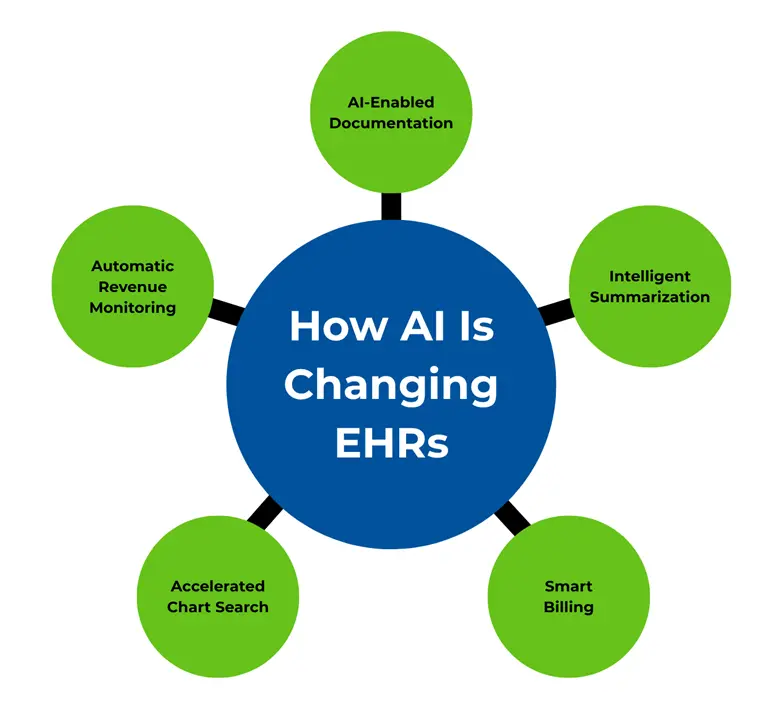Key Takeaways
- AI tools inside EHRs reduce documentation time and staff burnout.
- Intelligent summarization cuts through patient data overload.
- AI-enabled charge capture protects revenue without adding extra steps.
- Schedule a 1:1 with our team to learn about our AI features..
Feel like you’re spending way too much time in front of your EHR?
You’re not imagining things. While EHRs were built to simplify recordkeeping, they’ve often done the opposite—creating more boxes to check, more clicks to make, and more hours logged after your last patient leaves.
But thanks to a new wave of AI features, EHRs are finally starting to do what they were meant to: make your job easier.
From speeding up documentation to helping you get paid faster, AI in EHRs is solving real problems in real time. Here are five common headaches it can help relieve—starting now.
Table of Contents
1. Documentation That Eats Up Your Evenings
You see a patient for 15 minutes—and then spend 10 more charting the visit. Multiply that by a full day, and it’s no wonder providers are stuck doing paperwork long after hours.
That time adds up—and so does the toll. Providers who don’t have enough time for documentation are nearly 3x more likely to experience burnout.
AI EHR Solutions for Clinical Note Fatigue
AI-driven features like ambient listening, real-time transcription, and virtual scribes are now embedded within modern EHRs. These tools capture the conversation as it happens and convert it into structured notes—leaving you with a quick review and sign-off, not a blank screen.
That means fewer late nights, more accurate notes, and more time spent focusing on patients instead of data fields and clicks.
2. Drowning in Patient Data
Most charts are packed with labs, consults, scanned faxes, referrals, and patient messages. And with every new wearable, app, or external report, the pile grows. It’s no wonder that even experienced providers can struggle to spot what’s relevant in time for the appointment.
Here’s why that matters: 45% of malpractice claims are due to misdiagnoses, with 10% attributed to medication errors. Both of these missteps are exacerbated by fragmented information systems.
EHR and AI: Making Sense of Fragmented Information
AI summarization tools pull key details from the chart—like abnormal labs, recent diagnoses, or ED visits—and surface them in a simple summary. No more hunting through tabs or attachments. Just a focused, timely view of what matters most.
With EHR and AI working together, you walk into every visit prepared—not overwhelmed.
3. Costly Coding Mistakes
Even minor coding errors can lead to rejections, delays, or audits. According to one source, 32% of claim rejections are related to coding or documentation issues.
That’s not just frustrating—it’s expensive.
AI for EHR Systems That Protect Your Revenue
AI monitors your clinical activity and alerts you to missing charges—based on documentation, visit type, or common patterns. Some tools even auto-suggest charges in real time, so you can capture everything without extra effort.
It’s a safety net that keeps your revenue cycle intact—and your staff focused on care, not corrections.

4. Chart Searches That Waste Time
You know the data is there—but where? In long charts filled with years of encounter notes and uploads, even a single lab result can take several clicks too many.
That’s a growing problem. With nearly 129 million Americans living with at least one chronic disease, patient records are only getting longer.
AI EHR Solutions for Smarter Search
Large language model (LLM) search features inside AI EHR solutions make it easy. Just type a natural language query like “When was the last hemoglobin A1c?” and get an immediate answer—without combing through tabs or scrolling endlessly.
It’s like having a research assistant inside your EHR—one that never gets tired or distracted.
5. Revenue Leaks From Missed Charges
Most EHRs depend on manual charge entry. But in busy practices, it’s all too easy to skip a code or forget a service—especially when back-to-back appointments leave no breathing room.
Even small misses can snowball. Over time, unbilled charges can reduce overall revenue.
AI in EHRs Can Catch What You Might Miss
AI monitors your clinical activity and alerts you to missing charges—based on documentation, visit type, or common patterns. Some tools even auto-suggest charges in real time, so you can capture everything without extra effort.
It’s a safety net that keeps your revenue cycle intact—and your staff focused on care, not corrections.
Experience the EHR You Always Wanted
AI in EHRs isn’t some far-off promise. It’s already helping practices reduce documentation time, improve billing accuracy, and reclaim hours each week.
These tools don’t replace providers—they support them. They reduce noise, flag what matters, and take repetitive tasks off your list. So instead of working around your EHR, you can finally let it work for you.





 QUICK CHARTING
QUICK CHARTING NOTE
NOTE MEDICATION
MEDICATION PATIENT
PATIENT BILLING
BILLING RISK
RISK MARKETING
MARKETING MIPS
MIPS